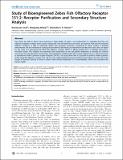Study of Bioengineered Zebra Fish Olfactory Receptor 131-2: Receptor Purification and Secondary Structure Analysis
Author(s)
Leck, Kwong-Joo; Zhang, Shuguang; Hauser, Charlotte A. E.
DownloadLecj-2010-Study of Bioengineered Zebra Fish Olfactory Receptor 131-2 Receptor Purification and Secondary Structure Analysis.pdf (330.0Kb)
PUBLISHER_CC
Publisher with Creative Commons License
Creative Commons Attribution
Terms of use
Metadata
Show full item recordAbstract
How fishes are able to detect trace molecules in large bodies of water is not understood. It is plausible that they use olfactory receptors to detect water-soluble compounds. How the zebra fish Danio Rerio, an organism with only 98 functional olfactory receptors, is able to selectively detect and recognize numerous compounds in water remains a puzzling phenomenon. We are interested in studying the biochemical and molecular mechanisms of olfaction in fish. Here, we report on the study of a bioengineered zebra fish olfactory receptor OR131-2, affinity-purified from a HEK293S tetracycline-inducible system. This receptor was expressed and translocated to the cell plasma membrane as revealed by confocal microscopy. Circular dichroism spectroscopy showed that the purified zebra fish receptor folded into an α-helical structure, as observed for other G-protein coupled receptors (GPCRs). Our study shows that it is possible to produce viable quantities of the zebra fish olfactory receptor. This will not only enable detailed structural and functional analyses, but also aid in the design of biosensor devices in order to detect water-soluble metabolites or its intermediates, which are associated with human health.
Date issued
2010-11Department
Massachusetts Institute of Technology. Center for Biomedical EngineeringJournal
PLoS ONE
Publisher
Public Library of Science
Citation
Leck, Kwong-Joo, Shuguang Zhang, and Charlotte A. E. Hauser. “Study of Bioengineered Zebra Fish Olfactory Receptor 131-2: Receptor Purification and Secondary Structure Analysis.” PLoS ONE 5.11 (2010) : e15027.
Version: Final published version
ISSN
1932-6203